Blackbeard the Pirate: the Truth Behind the Legend
[Editor's note: This is the most comprehensive biographical article on the internet about the notorious pirate, Blackbeard.]
In difficult economic times, any person worth their salt knows that even a shred of money is a treasure. This certainly applied to the "Golden Age" of maritime piracy in the Atlantic Ocean in the early 18th century—and its most famous pirate, Blackbeard.
Gainesville Coins is thrilled to offer the Blackbeard 1 oz silver round, an exclusive new design from Mason Mint! Follow the link to buy it now—and keep reading to learn more about the fascinating history of Blackbeard the pirate.
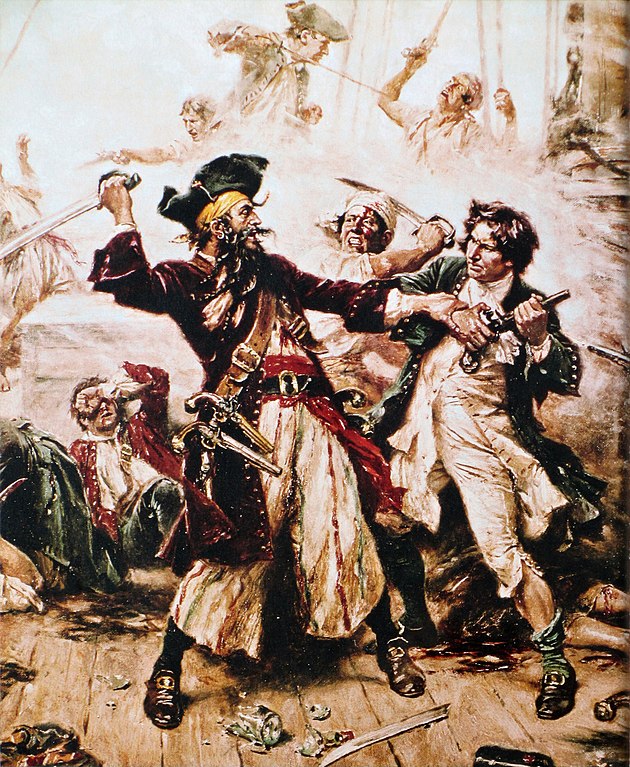
Capture of the Pirate, Blackbeard, 1718 by Jean Leon Gerome Ferris (1920)
Blackbeard was indeed the embodiment of the phrase "the brightest flame burns quickest," making a legend out of a 15-month career of piracy.
The image of his towering height, wild eyes, and three pistol holders—not to mention his iconic dark-as-night smoking hair—was undoubtedly imposing. The unhinged look put fear in the hearts of others. His flag and powerful souped-up ship, armed for battle and built for speed, also aroused terror. Not to mention his skills as a natural-born leader. Blackbeard was known for his dominance and charisma, so much so that when he helped co-captain a ship with fellow pirate Stede Bonnet, Bonnet’s crew liked him so much that they abandoned Bonnet and joined Blackbeard’s crew.
His exploits were legendary—so much so that we still think up adventures for him to this day. This includes appearances on the big screen in films such as Blackbeard’s Ghost (1968) or fighting against Jack Sparrow in Disney’s Pirates of the Caribbean 2: On Stranger Tides (2013), portrayed by Ian McShane. He’s also had multiple television appearances such as a 1968 episode of Dr. Who, several episodes of Disney’s TV series Once Upon a Time (2014), and he was the focus of two TV series running concurrently: NBC’s 2014 TV series Crossbones and Starz’s 2014 TV series Black Sails.
There are kernels of truth in all of his stories. But what is truth and what is fiction?
Blackbeard’s Origin
Who was this man? The history of Blackbeard is as murky as the sea itself. Experts speculate that he was possibly born in Bristol, England around the 1680s, placing his age in the mid-30s at the time of death. His very name is highly debated, although most agree that it was likely Edward Teach (or Thatch; there's been multiple variations of Tach, Thack, and Thache, just to name a few).
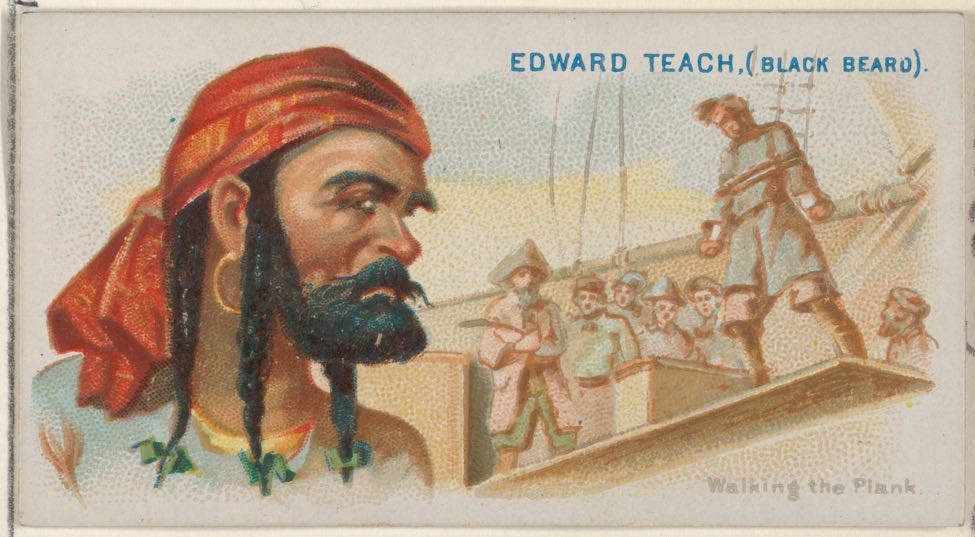
Teach has been featured in various media, from paintings to movies to even stamps.
It is suggested that he may have been born in Bristol and moved with his family to the Caribbean at a young age. Financially this makes a lot of sense since this was part of the new frontier. In the Caribbean, it was cheaper to be a landowner and invest your wealth in sugar cane, often called "white gold."
Many historians agree that he was likely well-educated as there were letters sent to him from multiple people. It is a fact that he knew the governor of North Carolina. Edward Teach was likely raised in a family that could afford to pay for a good education and gave him the opportunity to learn how to socialize in high society.
He likely entered the British Navy at a young age to gain his nautical experience. After some years on the water, he may have been interested in privateering, which may have led to meeting his future mentor, Captain Benjamin Hornigold.
Blackbeard’s Pirating Career
Records of his adventures with Captain Hornigold began in September 1717. Teach and Hornigold both served as privateers around the same time and it was Benjamin who turned to piracy first, with Teach following soon after. Hornigold may have not been the first person that Teach served under but he seemed to be the one that was the most influential in his pirating career. Teach got his own smaller ship in the spring of that year. It's possible he had already taken control of Stede Bonnet’s ship, the Revenge.
Bonnet was a pirate who had also recently started but lacked the charm and skill of Teach. We are unsure when Hornigold and Teach parted ways but it looks to be sometime between late September and the middle of November of 1717. During that time Teach was the captain of Bonnet’s ship, winning over many of his men in the process due to his strength of character and experience. Within weeks of being held Bonnet was regretting going into piracy at all due to his concern over Teach’s actions. Teach held him for some time before returning the ship, soon after gaining La Concorde.
Blackbeard's Ship: Queen Anne's Revenge
Teach seems to have had a habit of capturing larger ships using his imposing size and looks to scare his targets into submission. This would normally be very difficult for a ship of his size, but he must have realized early on that if he spread tales of his misdeeds he would be able to easily overpower larger ships on fear alone.
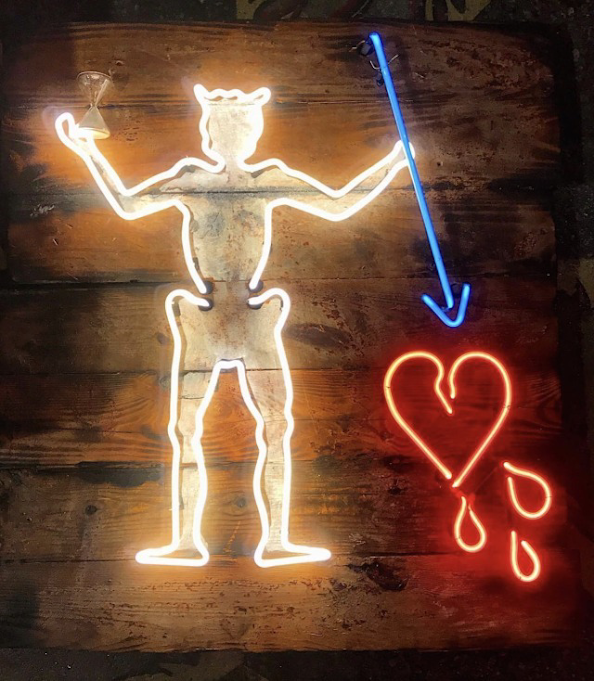
Blackbeard's distinctive pirate flag clearly communicated death would come to those who opposed them.
He would get this opportunity with his ship, La Concorde, a French vessel originally run by Captain Dosset. Dosset detailed the size of the ship for the French authorities at 200 to 300 tons. It was an escort to a convoy for the West African coast, across the Atlantic to Martinique, then through Tobago and Hispaniola. It made these rounds a few times before it was abandoned at the end of the Spanish Succession. The ship then came under the ownership of the Montaudoin family who had made their fortune participating in the slave trade in the Nantes area, then known as the center of the French slave trade.
The ship was refitted by the Montaudoins to become a slave ship, made very spacious and fast as was necessary to keep everyone alive during long trips. French documents record Teach’s possession of the ship as November 28, 1717. The account is told from the point of view of the last captain Charles Mesnier. He was only 60 miles from the port before La Concorde was surrounded by two small English pirate ships. Teach’s reputation grew exponentially and soon after refitting it for his own purposes, he returned the Revenge to Bonnet, sporting their new Jolly Roger.
Blackbeard's Legend Grows
From then on he would be known for his fearsome raids of ships and his complete disregard for the law. In one of his outlandish exploits, he once used his flotilla (a group of ships, smaller than a fleet) to blockade the port of Charlestown in the colony of South Carolina. While moored there his crew raided and plundered nine ships in the span of a week. Teach, realizing that he needed to stock up on supplies, told the prisoners that if he wasn’t able to get the medical supplies his ship needed that they would all be beheaded and their ships burned.
Teach decided that he would send two pirates and a prisoner to retrieve the supplies. Shortly after leaving the ship's sight, the group was never seen again. After several hours of waiting, Teach ordered for all eight ships in the flotilla to move into the harbor. The town panicked and the town was looted. Soon after the supplies were delivered and the prisoners were released unharmed, but they were robbed of all their possessions.
Not only did Blackbeard have the fear and respect of towns in the early days of the colonies but of his crew too. Legend has it that he once shot his first mate Israel Hands in the knee after the pirate had fallen asleep playing cards. When asked why he did it, he replied, “If I didn’t kill one of you every now and then you all would forget who I am.”
Another legend states that Teach toyed with his crew in an event now known by sailors as "dead man’s chest." He left 15 crewmen marooned on a small island near Tortola in the British Virgin Islands. He left the men with a chest, a cutlass, and a bottle of rum. Teach thought that they would fight and murder one another off the island for a bigger cut of the treasure. To his disappointment, all the men were found alive when he returned.
Blackbeard's adventures inspired many that came after him; but by the middle of 1718 his time was running out.
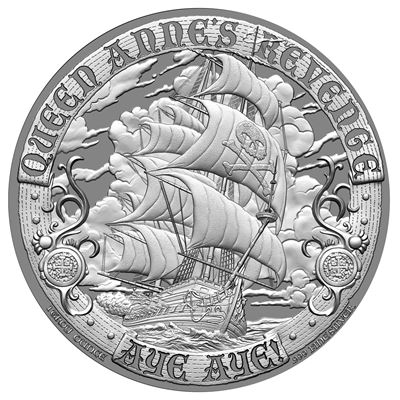
Queen Anne's Revenge was Blackbeard's famous pirate ship.
Blackbeard's Final Battle
Teach lost his prized ship the Queen Anne’s Revenge on June 10, 1718 at Topsail inlet (modern day Beaufort, NC). It had hit a sandbar and, due to its size, was nearly unmovable. He was on his way to receive a pardon from North Carolina Governor Charles Eden for his crimes.
Even after receiving the pardon he continued his piracy. Eventually, enough was enough. Virginia and South Carolina complained about months of losses due to the pirate and soon would turn to begging for help from a Virginia colonial governor, Alexander Spotswood.
Spotswood found out that William Howard, a former quartermaster who worked with Teach on the Queen Anne's Revenge, had been living in Virginia at the time. Although Spotswood had no mandate from the king, he wasted no time in arranging the arrest of Howard. Howard countered that Spotswood had no grounds for arrest. Spotswood's council then scrambled to throw reasons as to why the arrest was necessary.
Ultimately Howard was arrested on counts of piracy past the pardoner's cutoff date for acts committed in a sloop belonging to the Kingdom of Spain. This ignored the fact that these actions were done out of the governor's jurisdiction. Howard was found guilty and sentenced to be hanged. However, he was later saved by the Commission of London, which cited that Spotswood must pardon all acts of piracy committed by surrendering pirates by August 18, 1718.
Howard made it out unharmed but it was too late for Teach. Spotswood had gotten what he had wanted: Howard had given Blackbeard up. He revealed Teach and his men were on Ocracoke island near Bath Town.
The Hunt for Blackbeard Begins
Spotswood immediately got to work. Spotwood then set up a meeting with two naval officers Captain Ellis Brand who commanded the HMS Pearl and Captain George Gordon who commanded the HMS Lyme to come up with a plan to capture Teach in the area given to him by Howard. The problem was again that Spotwood's authority was very limited due to only having authority over Virginia waters with no jurisdiction in the colony of North Carolina. But he could get around that if these two officers decided to take part due to their power coming straight from the Crown. After speaking a while, he states his case: “Gentlemen, I have decided to expurgate that nest of vipers at Bath Town once and for all.” After listening to his idea both men agreed to plan. Spotwood added an extra bonus to sweeten the deal.
Spotwood ordered the two captains to travel overland to Bath and stop Blackbeard from escaping on land. Captain Brand’s Lieutenant Robert Maynard was given command of two ships, the Jane and the Ranger, run by an Officer Hyde and a total of 57 men. It was a combination of 33 men from the Pearl and 24 from the Lyme.
The plan was to block Teach in. The two captains took land while Maynard guarded from the sea. Leaving from Kecoughtan (now known as Hampton, Virginia) along the James River on November 17, 1718, Maynard's forces moved slowly to give Captain Brand's group time to reach the target town. They enlisted the help of local North Carolina forces, Colonel Moore and Captain Vail. Colonel Moore went into town to check for Teach and his men and also inform Governor Eden of their plan.
Maynard arrived on the scene on the evening of November 21, 1718. Due to not being familiar with the surrounding terrain, he decided to wait overnight and commence the attack in the morning. In the meantime, Maynard’s forces stopped all traffic going in and out of the inlet. He posted a lookout on either sloop in order to make sure no one would get in or out. Teach, on the other side of the island, was busy entertaining guests and did not think of setting a lookout. His first mate was on land with a good amount of his crew so in total it was said that Teach had about 25 men with him.
At daybreak Maynard’s forces began their trek into the channel. Almost immediately they were spotted. Teach’s ship fired as soon as Maynard’s ships were in sight. The Ranger quickly retreated to the side of the Jane and brought out the Union flag. Teach yelled out at Maynard, “Damnation, seize my soul if I give you quarters, or take any from you.”
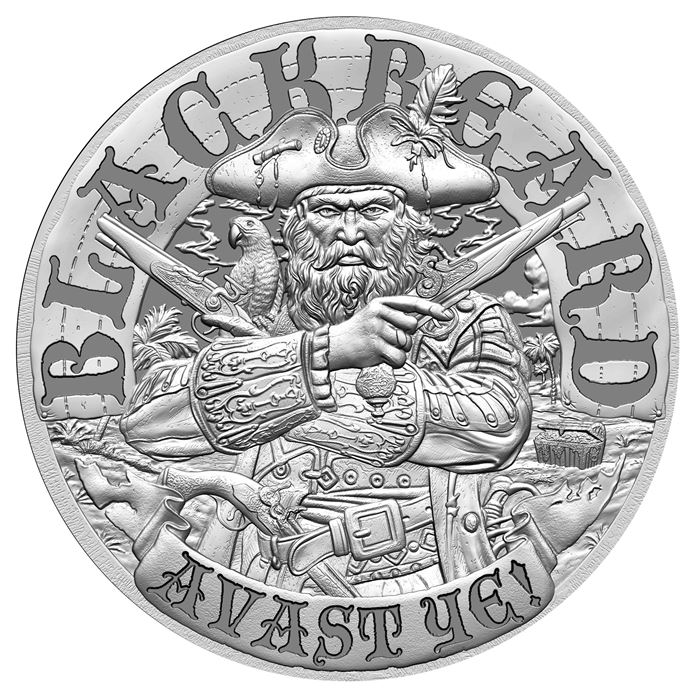
Much of the lore surrounding Blackbeard inspires our modern-day stereotypes of a pirate.
Teach ordered for the anchor line to be cut from his sloop, the Adventure, and to give chase. The Adventure turned starboard (right), turning their guns to the small sloops. The Adventure showed no mercy. Maynard lost a great deal of men, at least a third of his forces. His co-captain Hyde died almost immediately with 20 on the Jane either dead or wounded. Ranger had only fared a bit better with 9 injured or dead. Hyde’s ship was so damaged it was no longer suited for battle. Maynard got a lucky shot in and managed to cut the Adventure’s jib sheet, causing it to lose course and drift into a sandbar. At the same time, because of a lack of control due to loss of men, their ship may have also hit ground.
The Death of Blackbeard
Maynard had to take evasive action before Teach could board their ship. He instructed most of his men to go into hiding in the hold of the ship while he manned the stern. Teach’s men grappled the ship and sent bombs made from powder shot-filled bottles with ignited fuses. Once Teach’s men were aboard firing and shouting, Maynard called his men out of hiding and quickly outnumbered Teach’s men. They were taken aback at the retaliation. The two groups fought across the deck, covered with blood from the dead and injured.
Both captains fired their flintlocks at each other. Maynard managed to hit Teach, while Teach missed. Both then threw their flintlocks away and drew their cutlasses. Teach broke Maynard's cutlass at the hilt. The pirates were pushed back toward the bow, allowing the Jane's crew to surround Maynard and Teach. The pirates were overwhelmed by Maynard’s crew, who beat them in both number of men and better training. Teach was about to deliver a killing blow, but was slashed across the neck by one of Maynard's men. Because of this, Teach's cutlass struck Maynard's knuckles instead of killing him.
Teach was then attacked and killed by several more of Maynard's crew. He had been cut about twenty times and shot five times. After his death Maynard's crew beheaded him and placed the head on their ship, displaying him as a prize from their victory. What was left of the remaining pirates quickly surrendered. This included one pirate who left on the Adventure and had planned to set fire to the powder room and blow up the ship. Soon after his passing, the Queen Anne’s Revenge was thought to be lost forever, but Blackbeard’s influence lives on.
The Legacy of Pirates in Tampa Bay
In Florida we celebrate a famous legend of a pirate named José Gaspar—whose very portrayal is based on some of the exploits of Blackbeard. His story begins in 1756. Growing up, José was known for his intelligence and bravery. Due to familial circumstances, he joined the navy at a young age. After a series of events out of his control he quit to become a pirate in the Gulf of Mexico. His territory expanded to Tampa Bay where he had a great many adventures fending off the Spanish, who had cast him away, only to tragically fall at the hands of America’s might.
This legend and fascination with pirates rings especially true here in the city Tampa Bay. Every year for the Gasparilla Festival in the month of March, the streets fill up with folks from all over the state parading in the street with their pirate outfits while tossing beads from the parade floats. (It's essentially a city-wide pirate cosplay.) The city celebrates this long-standing tradition and the days-long parade is a show of prosperity and peace. These festivities bring out people from all walks of life and bring business to our city. The pirate’s spirit of adventure and tenacity remind us to pull ourselves up from our bootstraps and go for gold.
The Blackbeard Silver Coin Design
Gainesville Coins is proud to present the Blackbeard silver coin as a part of our Nautical series. The obverse features a portrait of Blackbeard himself, in all his wild black-haired and dual-pistols-wielding glory. The reverse shows the majesty of Queen Anne’s Revenge roaring through the high seas.
Click the image below to shop for the 1 oz Blackbeard silver round, a Mason Mint exclusive!
Blackbeard Bio
Real name: Edward Teach (or Thache)
Known for: being an infamous English Pirate during the early 1700s, and his fear tactic of using a long black beard tied with ribbons. Reportedly he would wrap slow burning lit fuses in his long black hair and beard, giving him a frightful appearance. Described as “like a frightful meteor.”
Where: the Caribbean and on the Atlantic east coast of North America (notably in North Carolina)
Time span: 15 months as a pirate
Flag design: depicted as a heart dripping blood and a skeleton holding an hourglass and spear. Likely used to instill fear into his enemies.
Ship: La Concorde, a slave transport ship stolen from the French, was renamed Queen Anne’s Revenge.
Death: November of 1718
Blackbeard's Notable Appearances in Media:
Disney’s Pirates of the Caribbean 2: On Stranger Tides (2013)
Blackbeard’s Ghost (1968)
Rick Riordan’s novel Sea of Monsters from the Percy Jackson series
An episode of Dr. Who (1968)
Disney’s TV series Once Upon a Time (2014)
NBC’s TV series Crossbones (2014)
Starz’s TV series Black Sails (2014)
Actor and Director Taika Waititi portrayed Edward "Ed" Teach (Blackbeard) in the HBO series Our Flag Means Death (2022)
Blackbeard was featured as one of the main antagonists of the long-running Japanese comic One Piece by Eiichiro Oda
Blackbeard (voiced Mark Bonnar) appeared as the mentor figure to the protagonist of the 2013 video game Assassin’s Creed: Black Flag
References
Blackbeard (aka Edward Teach), 28 Sept. 2016, www.nps.gov/people/blackbeard.htm.
“Who Was Blackbeard?” Royal Museums Greenwich, www.rmg.co.uk/stories/topics/blackbeard-edward-teach-pirate. Accessed 4 Aug. 2023.
Cartwright, Mark. “Blackbeard.” World History Encyclopedia, 4 Aug. 2023, www.worldhistory.org/Blackbeard/.
“Blackbeard.” Wikipedia, 2 Aug. 2023, en.wikipedia.org/wiki/Blackbeard#cite_note-88. (various sources)
Cabell, Craig, Graham A. Thomas, and Allan Richards. Blackbeard: The Hunt for the World's Most Notorious Pirate. Casemate Publishers, 2013.
d'Ans, André-Marcel. "The Legend of Gasparilla: Myth and History on Florida’s West Coast." Tampa Bay History 2.2 (1980): 3.
Written by Daniel Sandoval

